This website uses cookies so that we can provide you with the best user experience possible. Cookie information is stored in your browser and performs functions such as recognising you when you return to our website and helping our team to understand which sections of the website you find most interesting and useful.
Alto Adige: six wine trends to watch out for
Sandwiched between the Alps and the Dolomites, the northern Italian region of Alto Adige provides a high altitude haven for winemakers, as Louis Thomas discovered at this year’s Alto Adige Wine Summit.
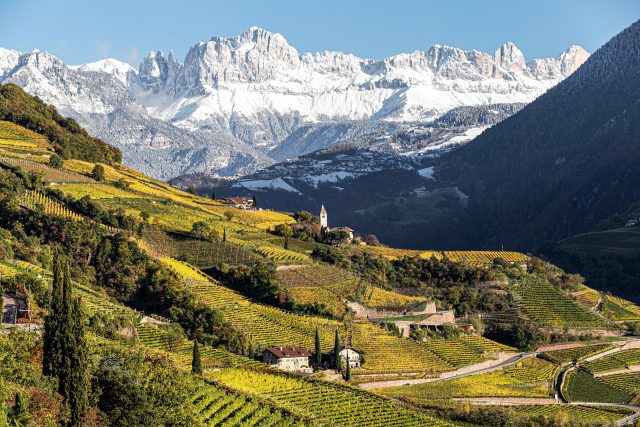
The summit, the first in two years, saw journalists, buyers and communicators gather in this small region bordered by Austria to the north and east and Switzerland to the west, to discover its wines and winemakers.
Taking place just before the harvest, the overall view of the 2023 vintage seems to be that it will not be the best, with the growing season affected by drought being followed by too much water, a similar phenomenon to what has happened in Piedmont. But Alto Adige is very different to other wine-growing parts of northern Italy in a number of ways…
High expectations
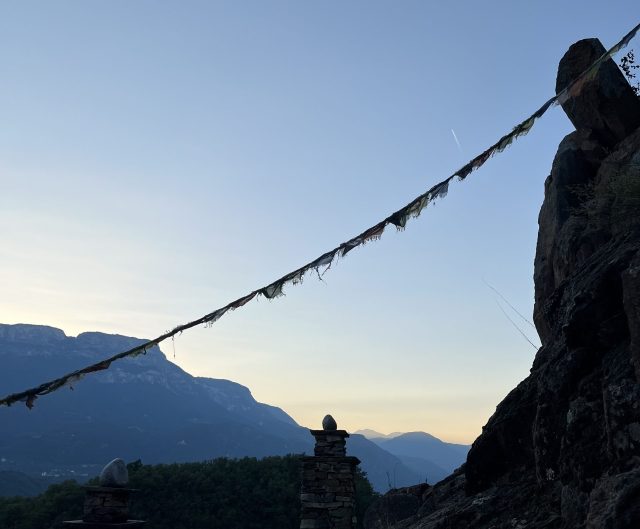
Alto Adige, also known as Südtirol/South Tyrol, is not a huge wine region by most standards. Nancy Gilchrist MW noted that the region’s 5,700 hectares of vines make it roughly equivalent in size to Saint-Émilion – meaning it makes up less than 1% of Italy’s total vineyard area.
But Alto Adige has strength in depth, or, rather, height.
Speaking at the final night of the summit, Alto Adige native, celebrated mountaineer and Castel Juval Unterortl Estate Winery owner Reinhold Messner noted the distinction between his two professions: “There is a big difference between winemaking and mountaineering: Alpinism is useless, wine is not.”
However, going uphill can have its uses for winegrowers.
A visit to the Laimburg agricultural research facility, just south of Bolzano, shed some light on the region’s climate concerns.
Despite Alto Adige’s high latitude in Italy, global warming has been noticeable. In 2022, the mean temperature in Bolzano was 14.3°C, 0.2°C above that of 2018. By 2100, the mean temperature is expected to be 2.5-4°C warmer, with an extra 20-30 summer days. For wine, the results will be higher pH and higher alcohol, due to the greater sugar content in the grapes.
Dr. Florian Haas, who works at the centre, noted: “We’ve become more comparable to Friuli – we’re losing some of the fruity, fresh style that characterises South Tyrol’s wines.”
“With temperatures rising, we rise in altitude,” Haas explained. Generally, for every 100 metres you go up, the average temperature drops by 0.6°C.
The drive to plant at higher and higher altitudes has been especially notable in Italy due to the country’s increasing extremes of weather, with producers from Alta Langa to Abruzzo noting that cultivating grapes at greater altitudes brings cooler conditions and lower humidity.
But is there an upper limit?
A research project in partnership with the European Union and Austria found that Pinot Noir’s general limit in Alto Adige is 1,100 metres above sea level – but, as Haas explained: “There are examples of wineries that have planted that high, but in three years they would only have two harvests.”
“Chardonnay fears high altitudes,” Haas said, “because it will not flower.”
Hail can also sometimes be an issue at these heights – Strasserhof, in Eisacktal, has 60% of its vines under protective netting, though apparently they are seldom needed. Strasserhof’s vineyards range from 500 to 1,000 m.a.s.l. in altitude.
Laimburg’s research also suggested that wines made from grapes grown at high altitude, be they Pinot Blanc or Pinot Noir, tend to exhibit less aromatic complexity than those grown at lower altitudes – blind tastings have also apparently backed this up.
Higher altitude planting is perhaps not the silver bullet to eliminate climate concerns – it’s certainly not a swift solution, given that the EU only permits 1% growth in a member state’s vine surface per year, meaning that the uphill crawl of vineyards is even slower.
But growers are nevertheless looking upwards. Messner, no stranger to conquering mountains, revealed that in the last 10 years his vine plantings have gone 100m higher. As he optimistically put it: “We can escape the problems we have with global warming.”
Giving pergola a pass
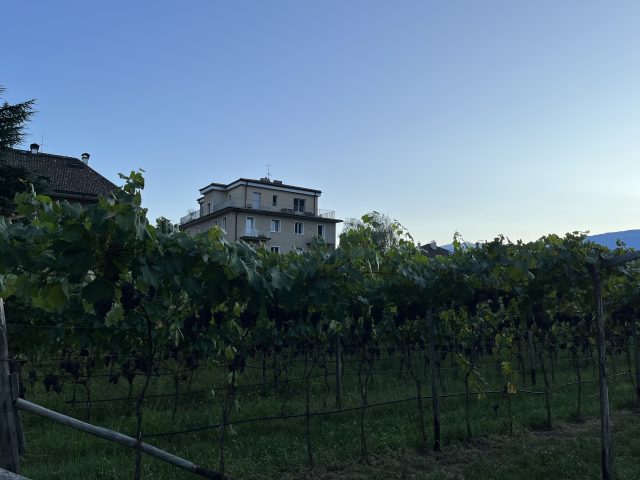
The unique conditions of high altitude viticulture has also caused growers in Alto Adige to buck a key trend that has been seen across the rest of Italy. Pergola vine training is a traditional technique that has surged in popularity again as the leafy canopy provides shade for the bunches hanging beneath – meaning that they are less likely to over-ripen or get sunburnt during the increasingly hot summers. Bertani Vineyards’ Andrea Lonardi MW recently discussed its advantages with db.
But in Alto Adige things are a little bit different: the go to training method today is Guyot.
Cantina Valle Isarco’s managing director Armin Gratl revealed that 97% of the cooperative’s vines are Guyot trained, the remaining 3% are old pergolas. Asked why Alto Adige opts for these more open rows of vines, he said: “We need more sunlight at altitude to achieve phenolic ripeness – with pergola training, the grapes are always in the shade.”
Generally speaking, if a vine is pergola-trained in Alto Adige, it is probably old.
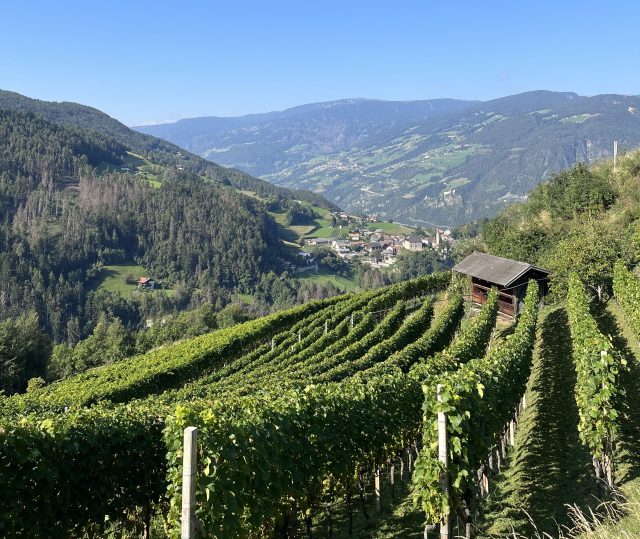
During the visit to Laimburg, a 1997 study was cited which also suggested that while pergola-trained vines might generally yield greater quantities, quality, at least in Alto Adige, was generally higher with Guyot, with greater varietal character in the final wines. Apparently the pergola system is still predominant in Trentino, which forms the southern half of the region of Trentino-Alto Adige.
Gratl additionally noted that Guyot vines are easier to maintain, particularly in terraced vineyards, as workers can have full access to the bunches without having to get beneath the canopy.
On the subject of vine maintenance, Haas at Laimburg revealed that its studies point towards minimal pruning actually being the best approach, with it supposedly requiring 75% less labour in the vineyard while still being harvestable by machine.
“We also think that minimally pruned vines are less susceptible to ESCA [a fungal disease that affects vine trunks],” Haas suggested, “because there’s less cutting, so there’s less possibility of infection.”
One downside Haas suggested is that the vines might have a shorter lifespan if minimally pruned, but argued that the reduced amount of work required to maintain them made up for it: “My vines might last 20 years instead of 40, but I will save a lot of money in that time!”
Gewürz is yet to come
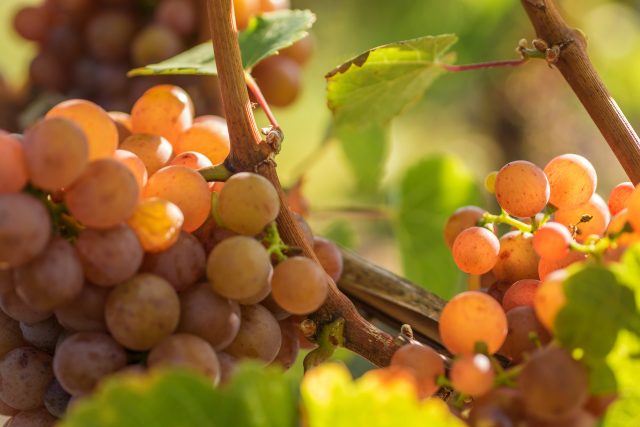
Alto Adige is perhaps the most un-Italian place one can find in Italy: German is the first language for the majority of its inhabitants, the cuisine feels more Austrian than anything (strudel is a popular dessert), Bolzano, or Bozen, even has its own Oktoberfest complete with steins of beer and lederhosen. Südtirol was part of the Austro-Hungarian Empire until after the conclusion of the First World War – today it remains a Teutonic outpost on the south side of the mountains.
It is therefore unsurprising that German and Austrian grape varieties have found a home away from home in the region: Sylvaner, Riesling, Grüner Veltliner, Müller-Thurgau, Kerner, Zweigelt and Gewürztraminer are all cultivated, alongside a host of local and other international varieties.
Culturally, it certainly makes sense that these grapes are popular.
“For speck [cured, smoked ham], Gewürztraminer is a very good pairing,” explained Wolfgang Klotz of Cantina Tramin, “though in Alto Adige having speck with Vernatsch [a local red variety] is more traditional, but that’s because every farmer had both in their cellar.”
The variety, locally known as Traminer, takes part of its name from the village of Tramin (which Cantina Tramin is also named after) – Gewürz means ‘spice’ in German, a reference to its strong aroma.
“The dry style of Gewürztraminer has become the typical style of Gewürztraminer in Alto Adige, and Italy in general,” added Klotz.
However, that is not to say that (ultra-premium) sweeter styles haven’t received critical acclaim. One such wine is Tramin’s Epokale, the 2009 vintage of which became the first Italian white wine to be awarded 100 points by Robert Parker’s Wine Advocate. The 2015 vintage has some 55 grams per litre of residual sugar, the soon-to-be released 2016 has approximately 60g/l – subsequent vintages will have around 30g more than that. On the secondary market, a bottle can fetch around the €500 mark.
According to the Consorzio Vini Alto Adige, today approximately 625ha of Alto Adige are under Gewürztraminer vines, making it the second most-planted variety, behind Pinot Grigio (683ha) and just ahead of Chardonnay (622ha).
In the vineyard, Gewürztraminer is also relatively forgiving, according to Klotz: “It is a variety that handles heat, but needs cool winds at nights.”
Haas at Laimburg had a slightly harsher view, going so far as to call Gewürztraminer a “prima donna”, noting that its berries are prone to shrivelling when there is a lack of Magnesium in the soil.
Return of the reds
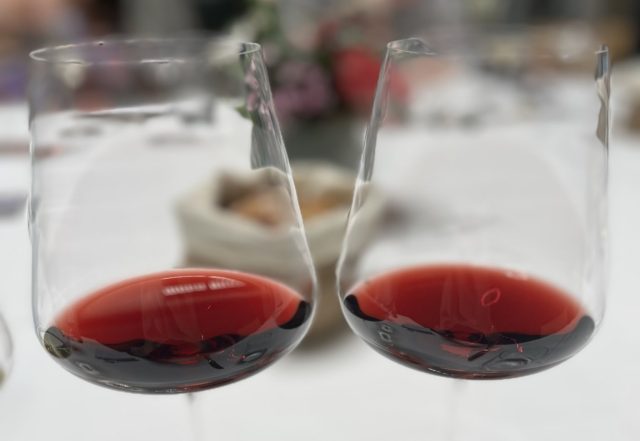
Today Alto Adige is very much a white wine region, with almost twice as much (64%) produced as red wine (36%). It is therefore something of a surprise that 50 years ago the inverse was true.
Schiava, also known as Vernatsch or Trollinger, is a thin-skinned, acidic variety that was dominant for decades upon decades – in 1972, 68% of Alto Adige’s vineyard area was producing Schiava. However, its popularity plummeted, and now it only constitutes 9%, or 506ha, making it the fifth most cultivated wine grape in the region.
One reason for this decline is that it’s a late-ripener, making it somewhat problematic during cooler vintages. It may also be a victim of the decline in pergola training, as the technique, according to the Consorzio Vini Alto Adige, suits the variety well.
Haas at Laimburg revealed: “Last year, our oenologist said that we were now at the quantity of Schiava where we need it, and shouldn’t cut anymore.”
When asked if he felt Schiava might make a comeback, Rielingerhof’s Matthias Messner said: “I hope so! It’s a really modern grape that makes very easy to drink wines. I think there’s a good future for it.”
Schiava is the key component of Südtirol St. Magdalener/Alto Adige S. Maddalena – a delicate red produced on the slopes north of Bolzano that has a small addition (up to 15%) of inky black Lagrein to give it more intensity and structure.
Today, one of the most important red varieties in the region is Blauburgunder, better known as Pinot Noir.
Marc Pfitscher, who heads up export and marketing for Girlan, described the variety as the cooperative’s “protagonist”, and noted that in the last 20 years the area it has devoted to Pinot Noir cultivation has increased from 20ha to 45ha.
Today, Girlan produces five labels of Pinot Noir from its two growing sites for the grape. One, situated 500 m.a.s.l. on volcanic soil tends to yield Pinot Noir with greater tannins, acidity and colour intensity, whereas the other, on calcareous soil 400 m.a.s.l. near the town of Tramin, tends to produce slightly softer wines that Pfitscher argued are “the most prestigious” Pinot Noirs in Italy. He also shared that Dijon Clone 777 is the most popular choice for planting.
Of course, Pinot Noir’s reputation as the ‘heartbreak grape’ is just as true in Alto Adige as it is anywhere else. Falkenstein winemaker Magdalena Pratzner amusingly dubbed it “a little diva when you get something wrong.”
Fortunately, when done right the wines are incredibly rewarding, offering structure, freshness and clear aromatic definition – they proved to be something of a personal highlight of the summit.
One advantage of increasingly warmer growing seasons has been phenolic ripeness, as Haas half-jokingly said when sniffing Laimburg’s 2020 Sass Roà Cabernet Sauvignon: “I love climate change – the reds have never been better!”
Perhaps global warming will give Schiava a new lease of life – if it gets as hot as it is projected to over the coming century, there may also be a need to return to pergola training too.
Sekt’s appeal
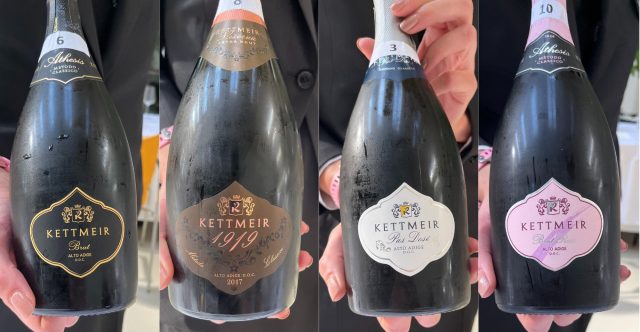
Haas remarked that Alto Adige has potential as a region of sparkling wine production: “South Tyrol is drinking a lot of Franciacorta and Trento DOC, but we could produce it ourselves.”
Indeed, there are producers making metodo classico spumante (or ‘sekt’, as the German-speaking population more commonly calls it). But, overall, Alto Adige produces only around 450,000 bottles of fizz a year – constituting just 1% of the region’s total wine production.
Those producers that do produce it, such as Kellerei/Cantina Kettmeir, tend to use the classic varieties for traditional method sparkling: Chardonnay and Pinot Noir, maybe with some Pinot Blanc too.
Whether Alto Adige’s current sparkling production is relatively small because its neighbours have already filled that gap in the market, or because winemakers prefer to stick to the tradition of still wine production, it doesn’t really matter, as bubbles could present a future opportunity for producers.
If growers are forced to plant at higher altitudes at the expense of aromatic complexity, and at the risk of underripe grapes, as Laimburg’s findings have indicated, then the fruit they harvest could be more suitable for the production of traditional method sparkling than for still wines.
Quality control
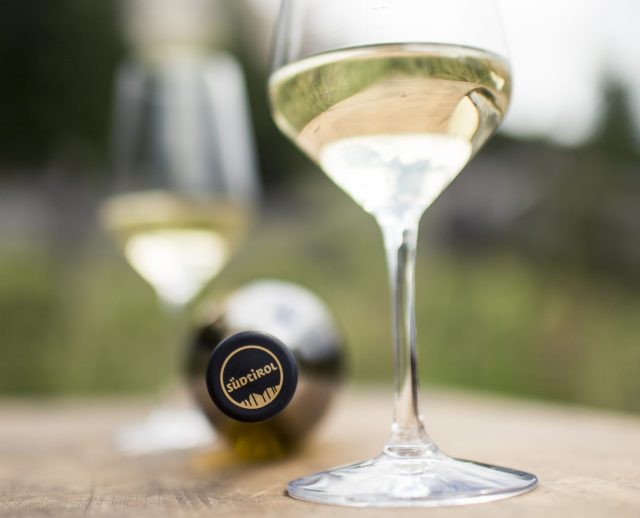
Of Alto Adige’s approximate annual production of 40 million bottles of wine, 70% are made by cooperatives.
According to Klotz at Tramin, Alto Adige’s relative isolation has created closer knit communities, facilitating the creation of these cooperatives, ranging from established giants, such as Kellerei Kaltern, all the way down to Cantina Valle Isarco, the region’s newest and smallest cooperative.
The system has grown and grown. Girlan, for example, was founded in 1923 with 24 growers across 25ha, today is is 230ha with around 200 growers, making it mid-sized for the region. Interestingly, the ratio of roughly one grower to 1ha has remained stable in the intervening century, both for Girlan and the region as a whole. Many growers will also cultivate other fruits, like apples and plums, as well as wine grapes.
“Our aim is to pay the highest possible price for the grapes,” Klotz explained, elaborating that keeping growers on side with generous pay meant that future generations were more likely to be interested in working in viticulture.
“Sustainability also means the social part,” to quote Strasserhof winemaker Hannes Baumgartner.
Furthermore, cooperatives have an edge when it comes to blending, as they can combine fruit from higher altitude vineyards, which may have better freshness, with that from lower altitudes, which often possesses more aromatic complexity.
“An advantage of the cooperative is to have pickers at hand,” Klotz added. “You can count on professionals every day.”
Haas at Laimburg revealed that labour shortages are still a pressing concern in Alto Adige, as they are across much of Italy: “The local labour force is really reduced – you need to hire workers from Eastern Europe. It is becoming harder and harder though, and we are having to look further and further east.” Slovakia and Romania, apparently, provide a considerable number of the vineyard workers in the region.
One thing that almost every producer encountered at the summit sought to emphasise was an approach of quality over quantity.
The shift towards high-end Pinot Noir and great Gewürztraminer, for example, is indicative of a belief in Alto Adige as a premium wine producing region – its dramatic geography certainly does not lend itself to churning out bulk wine.
Consorzio vice-president Martin Foradori summed it up on the opening night of the summit: “We don’t need to reinvent ourselves by consulting crystal balls or tarot cards…Our commitment is to make this unique terroir even more recognisable through our wines.”
Related reading:

